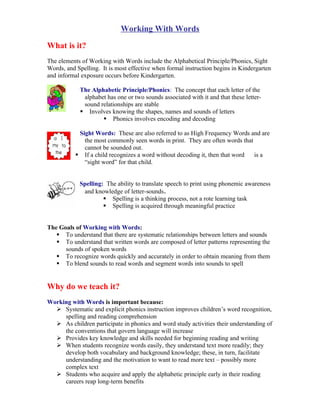
What is word work?
- 1. Working With Words What is it? The elements of Working with Words include the Alphabetical Principle/Phonics, Sight Words, and Spelling. It is most effective when formal instruction begins in Kindergarten and informal exposure occurs before Kindergarten. The Alphabetic Principle/Phonics: The concept that each letter of the alphabet has one or two sounds associated with it and that these letter- sound relationships are stable Involves knowing the shapes, names and sounds of letters Phonics involves encoding and decoding Sight Words: These are also referred to as High Frequency Words and are the most commonly seen words in print. They are often words that cannot be sounded out. If a child recognizes a word without decoding it, then that word is a “sight word” for that child. Spelling: The ability to translate speech to print using phonemic awareness and knowledge of letter-sounds. Spelling is a thinking process, not a rote learning task Spelling is acquired through meaningful practice The Goals of Working with Words: To understand that there are systematic relationships between letters and sounds To understand that written words are composed of letter patterns representing the sounds of spoken words To recognize words quickly and accurately in order to obtain meaning from them To blend sounds to read words and segment words into sounds to spell Why do we teach it? Working with Words is important because: Systematic and explicit phonics instruction improves children’s word recognition, spelling and reading comprehension As children participate in phonics and word study activities their understanding of the conventions that govern language will increase Provides key knowledge and skills needed for beginning reading and writing When students recognize words easily, they understand text more readily; they develop both vocabulary and background knowledge; these, in turn, facilitate understanding and the motivation to want to read more text – possibly more complex text Students who acquire and apply the alphabetic principle early in their reading careers reap long-term benefits
- 2. Children lacking skills in Working with Words: Experience unrewarding early reading experiences Become less involved with reading activities Cannot name certain letters and are likely to have trouble mapping sounds to their corresponding letters Do not learn how to decode words quickly and accurately; they will not have enough mental energy left to understand the meaning of text Working with Words Developmental Continuum Strengthening auditory and visual discrimination Emerging (Alphabetic Principle) Developing knowledge of letter-sound Relationships and patterns Developing Developing ground work for accuracy and fluency in decoding Developing a bank of sight words Fluent Establishing a core of strategies to apply to decoding and spelling Resources: http://reading.uoregon.edu/au/index.php http://www.usu.edu/teachall/text/reading/ReadBySight.htm Orchestrating Success in Reading. Dawn Reithaug The Four Blocks Model Researched-Based Methods of Reading Instruction. Sharon Vaughn
